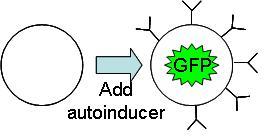User:Mbennie/Notebook/Projects/Inducible Cellular Adhesion
Idea
- Engineer a circuit that allows inducible cellular adhesion

- Introduction of autoinducer activates both transcription of GFP (to ensure cell has LuxR binding complex and to visually identify the cell) and a cellular adhesion protein

- Different cells could express different fluorescent proteins and different cellular adhesion proteins
Goals
- Create cells that can clump together when autoinducer is present
- Characterize several adhesion proteins and turn them into parts
- Mix several types of cells together and have them separate into clumps of single cell type

Current Plan
1. Express Omp in e coli with GFP attached (to ensure that the protein is in fact in the membrane)
2. Express Omp with full E-cadherin attached and subsets of E-cadherin attached
3. Measure adhesion efficiency of full E-cadherin and subsets of E-cadherin (how?)
4. Express cadherin-cleaving protein
5. Test that adhesion protein is cleaved (how?)
6. Insert into synthetic circuitry and test
Issues
- Reversibility?
- Specificity of adhesion proteins
- What type of adhesion protein?
Austin's Comments
- 6/13/2007
- Lacks milestones
- Just get working adhesion proteins first
- Need way to ensure that proteins work
- 6/19/2007
- Functional expression of foreign trans-membrane proteins in cells is very difficult
- Look into phages
Dated Notes
6/14/2007 - MIT 2007 IGEM team is working on something similar (unspecific binding). Their wiki creates some questions for me: How did someone transplant an adhesion protein that is found in mussels into e coli? I thought that the gram-negative nature of the e coli would render adhesion proteins from eucaryotic cells useless.
6/14/2007 - It appears that some of this work has already been started (although it appears with a different purpose) by Perry Tsai. There are several parts already in the library by him that include OmpA and Llp systems. The name of his project was 'Express monomeric streptavidin on E. coli cell surface'. He also engineered the protein to be expressed through the lac system.
6/15/2007 - It appears that Harvard 2006 IGEM team did something called 'cell surface targeting.' It does not appear to be what I am doing, but it seems that they built a bunch of useful parts and documented the process very well. If I end up going the Opm route, this would be a good place to start.
6/19/2007 - Cellular adhesion work being done at MIT: http://web.mit.edu/hyneslab/
6/20/2007 - MIT IGEM team might be working on specific cell-cell adhesion using Omp. I might want to go in a different direction.
Phages
- Injects bacteria with its DNA, which replicates and eventually lyses the cell releasing new phages
- Specific phages attack specific cells -> Phage typing
Cadherin Research
- Cadherin - family of adhesion molecules that is expressed in mammalian cells (found examples of protein in frog, chicken, and fruit fly).
- Nature has already provided us with several varieties: epithelial, neural, placental, etc
- About 5000 bp long
- Probably would have to use a eucaryotic cell to work with this protein (yeast?)
- Protein has five hour half-life
- Work might be directly correlated to tissue work in humans
- Calcium mediated
- Reversible: anti-cadherin monoclonal antibodies already exist [1]
- General overview of Cadherin's role in cancer
- There is a 'protein-cutting enzyme' that attacks cadherin protein produced by some cancers
- Binding is specific and homolytic
- Used in a natural system (doesn't seem like it would stick to itself or if it does, not all molecules stick together)
- Detailed review of cadherin family
- Might need catenin to provide structural linkage to cytoskeleton (p120ctn, alpha and beta catenin, alpha actinin, F-actin [already in cell?])
- Also found in c. elegans, mice, and sea squirt
- Yeast and membrane proteins
- 1/3 of proteins in eucaryotic cells are associated with the membrane
Omp Research
- Biotechnological applications for surface-engineered bacteria
- Complete list of surface presenting proteins from this paper:
- OMPs (these are already parts: BBa_J36836 BBa_J36837)
- OmpA Peptides
- LamB
- OprF
- PhoE
- OmpS
- OmpC
- FhuA
- BtuB
- Lpp´OmpA
- Invasin
- EaeA
- Inp
- OMPs (these are already parts: BBa_J36836 BBa_J36837)
- Complete list of surface presenting proteins from this paper:
- Autotransporters
- IgAβ
- AIDA-I
- Ag43
- MisL
- Extracellular appendages
- Fimbriae
- Flagella
- Autotransporters
- Other systems
- Peptidoglycan-associated lipoprotein
- TraT
- Pullulanse
- Other systems
- Display of proteins on bacteria
- Use OmpA or some other pre-established protein that spans double membrane to expose the protein of interest
- Has four loops outside the cell
- Could this be used to make a combinatorial code for cell adhesion (i.e. if I express four different adhesion proteins on the surface, is it possible that the cell would have to match each one of them to the appropriate domain to bind to another cell)
- LamB, OmpS both have nine outer loops
Other Research
- Intimin
- Expressed in e coli already
- Requires translocated intimin receptor (Tir) on other cell
- Adaptamer